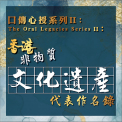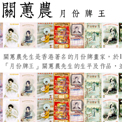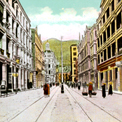-
History & Society
- Education in Pre-war Hong Kong
- History of Taikoo Sugar Refinery
- Hong Kong Products Exhibition
- Local Festivals Around the Year
- Post-war Industries
- Pre-war Industry
- The Hong Kong Jockey Club Archives
- Tin Hau Festival
- Memories We Share: Hong Kong in the 1960s and 1970s
- History in Miniature: The 150th Anniversary of Stamp Issuance in Hong Kong
- A Partnership with the People: KAAA and Post-war Agricultural Hong Kong
- The Oral Legacies (I) - Intangible Cultural Heritage of Hong Kong
- Hong Kong Currency
- Hong Kong, Benevolent City: Tung Wah and the Growth of Chinese Communities
- The Oral Legacies Series II: the Representative List of the Intangible Cultural Heritage of Hong Kong
- Braving the Storm: Hong Kong under Japanese Occupation
- A Century of Fashion: Hong Kong Cheongsam Story
Geography & EnvironmentArt & Culture- Calendar Posters of Kwan Wai-nung
- Festival of Hong Kong
- Ho Sau: Poetic Photography of Daily Life
- Hong Kong Cemetery
- Sketches by Kong Kai-ming
- The Culture of Bamboo Scaffolding
- The Legend of Silk and Wood: A Hong Kong Qin Story
- Journeys of Leung Ping Kwan
- From Soya Bean Milk To Pu'er Tea
- Applauding Hong Kong Pop Legend: Roman Tam
- 他 FASHION 傳奇 EDDIE LAU 她 IMAGE 百變 劉培基
- A Eulogy of Hong Kong Landscape in Painting: The Art of Huang Bore
- Imprint of the Heart: Artistic Journey of Huang Xinbo
- Porcelain and Painting
- A Voice for the Ages, a Master of his Art – A Tribute to Lam Kar Sing
- Memories of Renowned Lyricist: Richard Lam Chun Keung's Manuscripts
- Seal Carving in Lingnan
- Literary Giant - Jin Yong and Louis Cha
-
History & SocietyGeography & EnvironmentArt & Culture
-
View Oral History RecordsFeatured StoriesAbout Hong Kong Voices
-
Hong Kong MemoryA Century of Fashion: Hong Kong Cheongsam StoryRecently Visited
Steps (1)
Making a cheongsam involves a series of very elaborate procedures that includes some twenty steps from taking body measurements, making the pattern, cutting, ironing, gluing, sewing and fitting. Before commissioning a cheongsam from a tailor, however, the patron first has to select the fabric. She will then tell the tailor the style of cheongsam that she wants.
The first and foremost step in making a cheongsam is to take the measurements of the patron. In the period before the Second World War when Hong Kong society was still very conservative and cheongsams were generally wide and loose, a tailor could get a good idea of the measurements by using a stiff ruler and his own experience eyes. Measuring tapes began to be used in the 1950s when making a cheongsam with a closer fit. The rulers and measuring tapes used by cheongsam tailors are scaled according to the traditional Chinese decimal system.
After taking the measurements, most tailors will make use of a ‘chalk powder bag’ to ‘cast’ patterns on the fabric, a technique known as ‘casting powder lines’. The different parts of the cheongsam are then cut out from the fabric along the chalk marks. Only a small number of tailors bother to draw up paper patterns. The work takes place on a cutting bed, a multipurpose assembly that serves as a worktable, an ironing board, a storage area and even an actual bed for sleeping. With the exception of the sewing machine, all the tools that are used by a tailor to make a cheongsam are placed on the cutting bed.
Photos
Copyright © 2012 Hong Kong Memory. All rights reserved.













